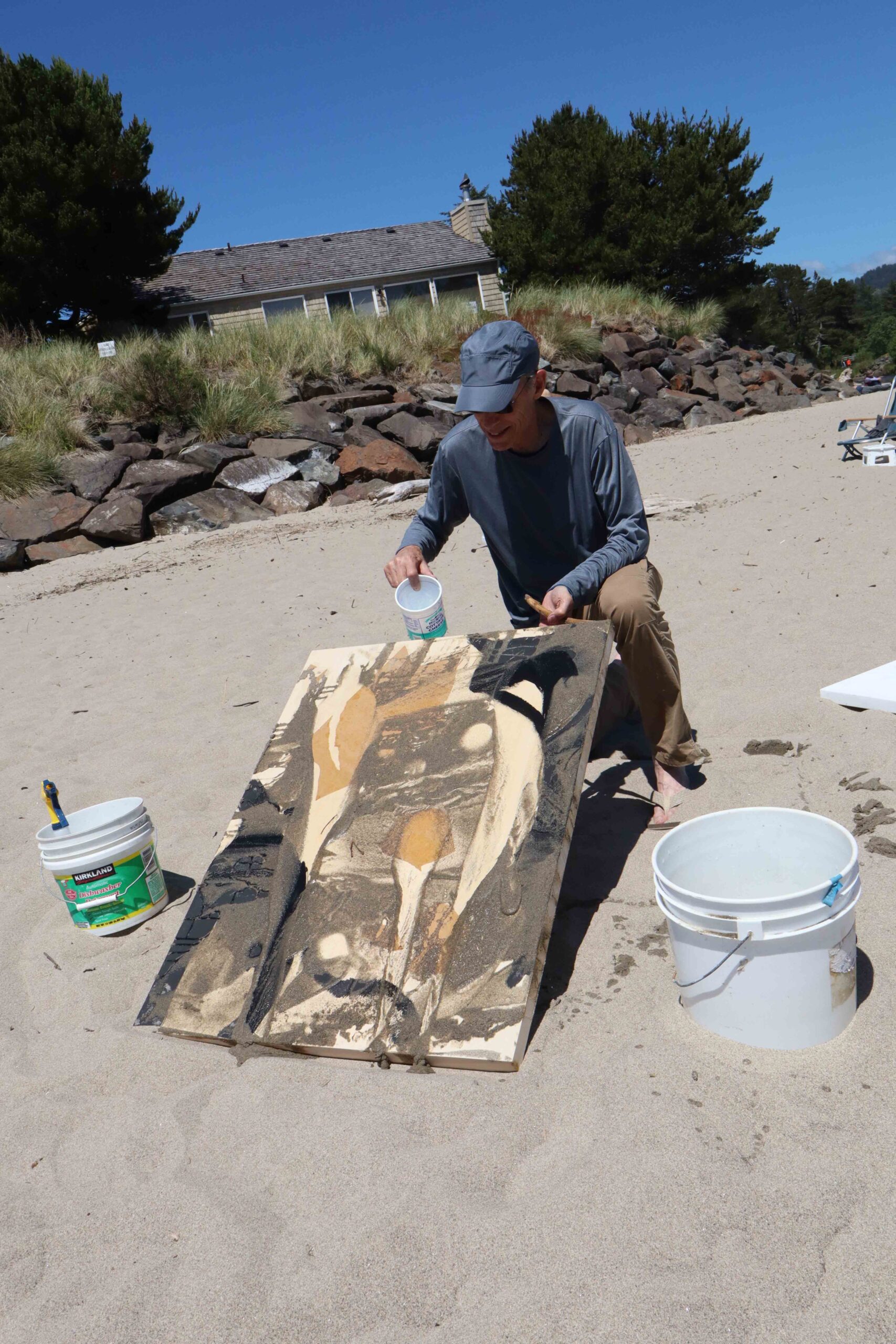
Description
Dive deep into this exciting workshop exploring the immense Pacific Northwest landscape through layers of mixed media collage and paint. In four studio days, participants will achieve three or more large artworks on panel and canvas reflecting the rugged coastal landscape. Using sand, paper, paint, wood, stone and bone students develop invented surfaces that investigate perspectives, explore color development and unconventional composition to inform and enrich their own studio practices. Those new to mixed media are welcome to join returning sand painters and practiced surface builders for the new and ever-expanding exploration of tricky techniques. New things are always happening in this salty, spine-tingling workshop!
About the Instructor
Oregon painter Judy Vogland explores the vast Pacific Northwest landscape through the magic of surface building and mixed media collage. Vogland engages students to develop aesthetic landforms that work best on large canvases. She shares her trusty secrets and bag of tricks to inspire students to investigate unconventional perspectives and invented surfaces and develop new color relationships while students master creative problem solving! This long-time artist has been teaching courses while painting and exploring the crust of the ocean for the past 43 years.
Learn More
www.judyvogland.com
Materials List
You will need to bring:
Essential:
- Workshop starts at 9 AM. Dress for the weather, walking, and beach time.
- Feel free to bring used equipment or share to reduce costs.
Canvases:
- Sand painting works best on canvases that are built for rugged handling on the beach.
- Since this is a 4-day workshop, participants need to come prepared with 3 (or more) canvases/panels—either sized or unsized and ready to go.
- Unsized stretched canvas is preferred. If you’re purchasing instead of making, you’ll find only sized canvases, but these will work fine too.
- I will mail participants who are building their own canvases a diagram of materials and directions. It takes about one hour to build each canvas from start to finish (preferably unsized with no gesso). If this is your first time building a canvas, be sure to contact me ahead of time to get your materials.
- A good alternative to building your own is buying a ready-made canvas. The Dick Blick Premier Gallery canvas is sturdy, has a 1.5″ profile, and is available in larger sizes. This will be your biggest expense, but it’s a durable surface that can be framed and enjoyed for years.
- Canvas/Panels Needed: Buy or make 2 canvases and 2 wood panels close to these dimensions:
- 30″x36″, 24″x48″, 30″x40″, 12″x48″, 12″x36″, or 36″x48″.
- You may bring more than 4 canvases/panels, but plan to work within these proportions for the workshop. Larger is better, as long as your transportation can manage.
Wood Panel Choices:
- You can buy birch panels from Blick Studio Panels at Dick Blick’s or purchase them from Judy’s workshop if prearranged with her.
- Manufactured by artsubstrates.com, Matt McCalmont at 971-222-5710. Call Matt directly; he is the best supplier for what we do.
Supplies Needed:
- 2 large 3-5 gallon buckets PLUS 1 quart-size plastic container for pouring.
- 3 clean, empty plastic utility spray bottles with a big straw (skinny straws tend to clog).
- Comfortable clothes, camera, swimsuit (?), hat, sunscreen, towel or mat.
- A few sheets of newsprint, white (no print) paper towels, brown paper grocery sacks, or brown kraft paper.
- Assorted rice papers or cool things you find in Dick Blick’s paper drawers (2-3 sheets).
- 3 brushes:
- One 1.5″ all-purpose white bristle (about $2) from a hardware store.
- Two decent hog or oil paint bristle brushes #6, #8, or #10 (filbert or round bristles) from Blick.
- 1 palette knife or old credit card for spreading paste.
- 1 quart of Golden Brand Gloss Medium (NOT gel, NOT glazing fluid). A pint is not enough. A gallon will last a long time and can be shared with another participant.
- Golden Brand Crackle Paste (16 oz)—it’s not cheap but is pretty cool. You can buy a smaller quantity, but it lasts and is fun to use.
- Ebony pencil or stick of graphite.
- Snap-off style razor knife and decent scissors for trimming paper.
- Any assorted scrap paper you’ve saved for something fun!
For Returning Sand Painters:
- A box full of “stuff”, salvage finds, metal scraps, old architectural treats—rusty is good!
- 1-2 old books that you can tear apart.
Required Acrylic Paints:
- Golden Brand Titanium White and Payne’s Grey (4 oz size with “Fluids” on the label).
- Liquitex brand (2 oz size) OR Golden Brand (1 oz size) colors:
- Yellow Hue, Red Hue, Alizarin Crimson Hue, Ivory Black, Burnt Sienna, Phthalocyanine Blue, Phthalocyanine Green, Violet, Yellow Ochre, Raw Umber.
- Watch out for the Series #—the higher the number, the more expensive the paint.
- Bring what you can from the list, or bring what you like to use and are comfortable with!
- Acrylic Hues: Iridescent coppers, silvers, and bronzes (1 oz size) for fun.
Important Reminder:
- It pays to use higher-quality materials, as your finished work will hold up longer and reflect better color and consistency. Fluid paints are easier to use than tube hues for sand painting.
Provided by instructors:
Assorted rice papers
Handmade and colored tissue papers
Backup Golden Gloss Medium
Wood glues
Plaster wrap
Porcelain clay slip
DAS Paper Clay
Backup supply of substrates
Tools and equipment for assembly